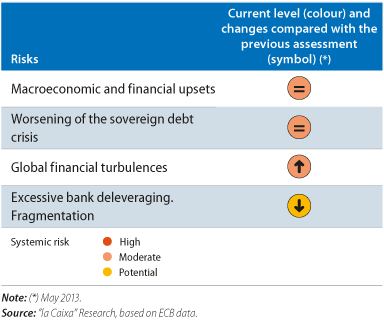
The first great source of risk identified by the ECB is related to possible macroeconomic and financial shocks affecting asset valuations and the generation of profit in the banking sector. Modest growth prospects and the high rate of unemployment in the euro area directly jeopardise the quality of bank assets and this, in turn, restricts the supply of credit, further reinforcing the weakness. But 2014 will provide a good opportunity to reverse this situation: the banking solidity and stress tests (which will actually be carried out by the ECB) should serve to strengthen the position of the sector, both in terms of effective solvency (by means of appropriate recapitalisation) and also transparency.
The second risk factor is related to possible outbreaks of tension in the sovereign debt markets. This could occur should there be a delay in implementing the structural reforms required to correct fiscal imbalances and the loss of competitiveness in some countries. Although this has been one of the areas in which substantial improvement was made in 2013 (a generalised fall in periphery risk premia), a weariness with reforms or excessive complacency on the part of government authorities (both national and European) could bring about a recurrence of instability in this area. It is crucial to avoid such a mistake.
The road taken towards the progressive normalisation of monetary policy in the USA represents a third source of financial unrest. After Ben Bernanke's announcement in May concerning the intention to start tapering at the end of 2013, the markets became highly unstable, particularly visible in the emerging countries but also in the euro area. Although the measures adopted by the ECB have helped to mitigate the impact of the Fed's «manoeuvring» on EMU interest rates, the risks associated with a possible new phase of sharp rises in global interest rates cannot be ignored. Although, for the time being, the Fed's announcement that it would start tapering as from January 2014 has not caused any significant disruption, the ECB must be ready and willing to take further action should this be required.
The fourth risk perceived by the ECB is excessive and disorderly deleveraging on the part of banks, which could be exacerbated if banks from countries undergoing adjustments find it difficult to secure funding on the capital markets. Fortunately, the fragmentation between countries (core versus periphery) in terms of the availability and cost of credit for individuals and firms has shown some signs of improvement over the last few months. The progress made in creating a real Banking Union has been critical in this respect and will continue to be crucial in the future.
In short, the panorama of financial stability has improved, the risks are still significant but financial authorities and institutions have it within their power to neutralise them.
Recommended Content
Editors’ Picks
EUR/USD clings to gains above 1.0750 after US data

EUR/USD manages to hold in positive territory above 1.0750 despite retreating from the fresh multi-week high it set above 1.0800 earlier in the day. The US Dollar struggles to find demand following the weaker-than-expected NFP data.
GBP/USD declines below 1.2550 following NFP-inspired upsurge

GBP/USD struggles to preserve its bullish momentum and trades below 1.2550 in the American session. Earlier in the day, the disappointing April jobs report from the US triggered a USD selloff and allowed the pair to reach multi-week highs above 1.2600.
Gold struggles to hold above $2,300 despite falling US yields

Gold stays on the back foot below $2,300 in the American session on Friday. The benchmark 10-year US Treasury bond yield stays in negative territory below 4.6% after weak US data but the improving risk mood doesn't allow XAU/USD to gain traction.
Bitcoin Weekly Forecast: Should you buy BTC here? Premium

Bitcoin (BTC) price shows signs of a potential reversal but lacks confirmation, which has divided the investor community into two – those who are buying the dips and those who are expecting a further correction.
Week ahead – BoE and RBA decisions headline a calm week

Bank of England meets on Thursday, unlikely to signal rate cuts. Reserve Bank of Australia could maintain a higher-for-longer stance. Elsewhere, Bank of Japan releases summary of opinions.